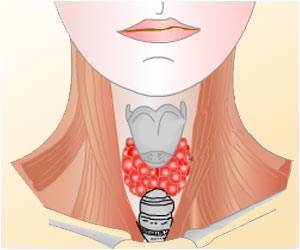BRAF V600E genetic mutation is associated with a higher cancer-related death among patients with papillary thyroid cancer (PTC), finds study published in JAMA.

Mingzhao Xing, M.D., Ph.D., of the Johns Hopkins University School of Medicine, Baltimore, and colleagues conducted a study to examine and define the association between the BRAF V600E mutation and PTC-related mortality. The study included 1,849 patients (1,411 women and 438 men) with a median (midpoint) age of 46 years and an overall median follow-up time of 33 months after initial treatment at 13 centers in 7 countries between 1978 and 2011.
The overall prevalence of BRAF V600E was 45.7 percent (845/1,849). There were 56 PTC-related deaths among the 1,849 patients, representing an overall mortality of 3.0 percent. Among these deaths, 45 cases (80.4 percent) were positive for BRAF V600E. The overall mortality of all PTC cases was 5.3 percent (45/845) in BRAF V600E-positive patients vs. 1.1 percent (11/1,004) in mutation-negative patients.
When the aggressive tumor features of lymph node metastasis, extrathyroidal invasion, and distant metastasis were also included in the model, the association of BRAF V600E with mortality for all PTC was no longer significant, the authors write. "A higher BRAF V600E-associated patient mortality was also observed in several clinicopathological subcategories, but statistical significance was lost with adjustment for patient age, sex, and medical center."
"In summary, in this multicenter study, the presence of the BRAF V600E mutation was significantly associated with increased cancer-related mortality among patients with PTC. However, overall mortality in PTC is low, and the association was not independent of tumor behaviors. Therefore, how to use BRAF V600E for the management of mortality risk among patients with PTC is not clear. These findings support further investigation of the prognostic and therapeutic implications of BRAF V600E status in PTC."
Source-Newswise















